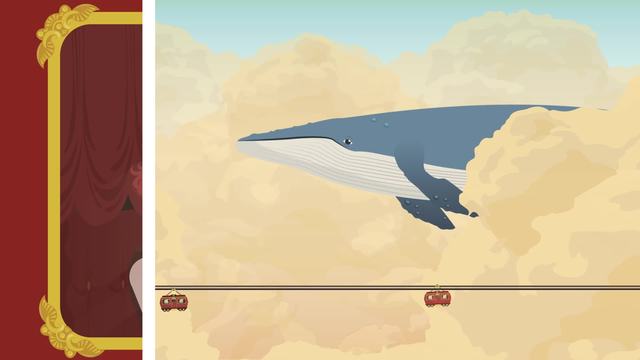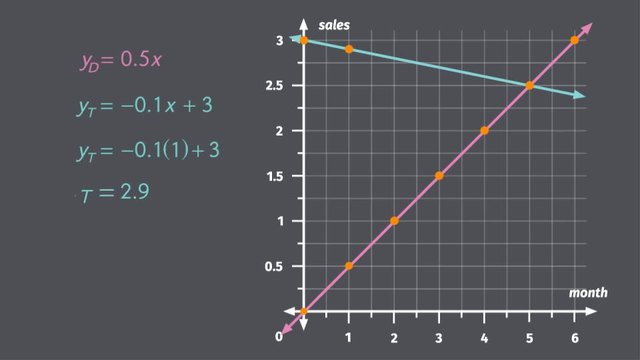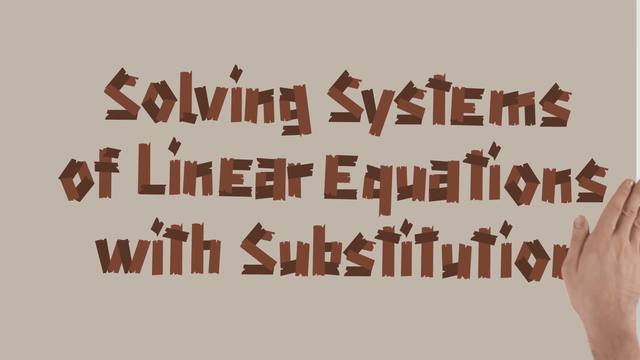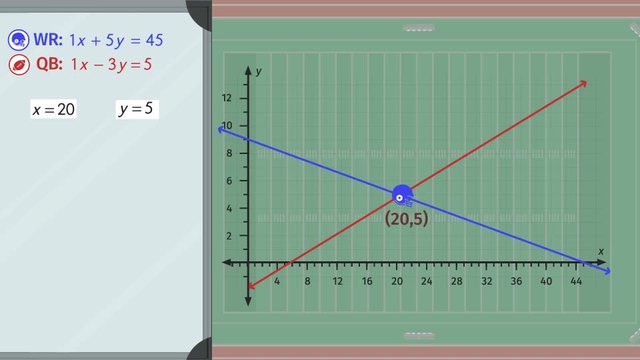Characterization of Parallel Lines


Basics on the topic Characterization of Parallel Lines
After this lesson, you will be able to identify parallel lines and their characteristics.
The lesson begins with two linear equations and their graphs. The example leads to a formal definition of parallel lines, and how that relates to slopes and systems of equations. It concludes by showing how rewriting equations in slope-intercept form can help identify if two lines are parallel.
Learn about parallel lines with Cassandra and Spark in Aerial City!
This video includes key concepts, notation, and vocabulary such as parallel lines (lines are parallel if they have the same slope but different y-intercepts), slope-intercept form (y=mx+b where m is the slope and b is the y-intercept), and system of equations (a set of equations on the same graph, occurring simultaneously).
Before watching this video, you should already be familiar with slopes of lines, slope-intercept form, and graphing equations.
After watching this video, you will be prepared to learn more about the characteristics of lines and systems of equations.
Common Core Standard(s) in focus: 8.EE.B.5, 8.EE.C.8 A video intended for math students in the 8th grade. Recommended for students who are 13 - 14 years old.
Transcript Characterization of Parallel Lines
Welcome to Aerial City, built on two interconnected islands in the sky. Citizens travel between Upper Aerial and Lower Aerial using the world-famous Parallel Cable Cars. Two strangers, Cassandra and Spark, pass each other on the cable cars every day. Cassandra is always on her way to Upper Aerial and Spark is always headed down to Lower Aerial. We can see their paths will never cross. But do you know why? To find out, let’s take a look at the characteristics of parallel lines. The Parallel Cable Car routes in Aerial City are represented by these linear equations. Are these lines truly parallel? Lines are parallel if they have the same slope but different y-intercepts. We can easily identify the slope and y-intercepts in these equations, because they are already in slope-intercept form, 'y equals mx plus b'. The slope 'm' in both of these equations is 3, so the slopes are the same, but the y-intercepts, or b, are different: 5 and 6, respectively. These linear equations have the same slope and different y-intercepts, so they must be parallel. This is what the graphs of the two lines look like when we plot them on a coordinate plane. Both lines have the same shape and steepness, but they pass through an entirely separate set of points. Which means these lines will never intersect! Remember how we solved systems of equations to find a point of intersection? What do you think happens when we try to solve this system, when we know the lines never intersect? Let's assume the 'y's in both equations are equal. Then, we can set '3x plus 5' equal to '3x plus 6'. Subtracting 3x from both sides to isolate the variable gives us 5 is equal to 6. Wait, that’s not right! When solving a system of equations leaves you with a false mathematical statement like '5 equals 6,' it means there's no ordered pair that works as a solution to this system of equations. That also means there are no points of intersection so the lines don’t cross: they’re parallel. Let’s look at another system of equations. It's hard to tell if these lines are parallel, so let's rewrite their equations using slope-intercept form, or 'y' equals mx plus 'b'. This will allow us to easily identify their slopes and y-intercepts. We'll start with the first equation, '2x plus 8y equals 10'. To isloate the 'y', subtract 2x from both sides and divide both sides by 8. Then, simplify the fractions. Now we have the equation "y equals negative one-fourth 'x' plus five-fourths. From this, we can determine the slope 'm' is negative one fourth and the y-intercept 'b' is five-fourths. Now, let's get the second equation in slope-intercept form. To isolate the 'y', use opposite operations and add 2 to both sides. Then divide both sides by 4 to cancel out the coefficient of 'y'. Then, simplify any remaining fractions and we are left with the equation "negative one-fourth x plus one-half equals 'y'". To put this in the more familiar form of "y equals mx plus b", let's rearrange things so the 'y' variable is on the left side. Now we can easily see that the slope 'm' is negative one fourth, and the y-intercept 'b' is one-half. Comparing our two equations, we can see that the slopes are the same but the y-intercepts are different. Hey, that's the definition of parallel lines! If we want to check that they are in fact parallel, we can set the two equations equal to each other. Sure enough, when we try to solve for 'x' by adding one-fourth 'x' to both sides, we end up with a false statement of five-fourths equals one-half. Looks like this system of equations has no solution, so these two lines will never meet. Let's quickly review. When determining if two lines are parallel, put their equations in slope-intercept form, 'y equals mx plus b'. Lines are parallel if they have the same slope, but different y-intercepts. You can also set them equal to each other and try to solve for 'x'. If you end up with a false statement, like 5 equals 6, then you know these lines will never intersect, so they are parallel. But if these parallel lines never intersect, does that mean Cassandra and Spark will never meet?
Characterization of Parallel Lines exercise
-
Determine if the given pairs of lines are intersecting or parallel.
HintsSlope-intercept form for a line is $y=mx+b$. The following lines are in slope-intercept form:
$\begin{array}{l} y=x+10\\ y=\frac12 x-7\\ y=-5x+\frac23\\ y=6\\ \end{array}$
Line with the same slope are parallel. Their $y$-intercepts must be different, otherwise they would be the same line. The following lines are parallel:
$\begin{array}{l} y=\frac56 x+3\\ y=\frac56 x\\ y=\frac56 x - 4\\ \end{array}$
Standard form for a line is $ax+by=c$. Here are some examples:
$\begin{array}{rcc} -3x+4y &=& 9\\ \frac67 x-9y &=& 0\\ x-y &=& 4\\ \end{array}$
We can convert a line from standard form to slope-intercept form by solving for $y$. Here's an example:
$\begin{array}{rcl} 2x+3y&=&6\\ \mathbf{-2x}&&\mathbf{-2x}\\ \\ 3y&=&-2x+6\\ \mathbf{\div3}&&\mathbf{\div3}\\ \\ y&=&-\frac23 x +2\\ \end{array}$
SolutionHere is the first pair of lines:
$\begin{array}{l} y=2x+1\\ y=5x-8\\ \end{array}$
- These lines are in slope-intercept form ($y=mx+b$).
- Their slopes are $m=2$ and $m=5$, so their slopes are different.
- That means the lines must intersect.
- To solve the system, we create the equation:
- Solving this gives us $x=3$, which means the system has a solution.
- This confirms that the lines must intersect.
$\begin{array}{l} -x+y=-3\\ -x+y=2\\ \end{array}$
- These lines are in standard form ($ax+by=c$).
- We convert them to slope-intercept form by solving each for $y$:
- The slope of each line is $m=1$, so the slopes are the same.
- Lines with the same slope are parallel--they don't intersect.
- To solve the system, we create the equation:
- Solving this gives us $-3=2$, which means the system has a solution.
- This is a false statement, so the system has no solution.
- This confirms that the lines do not intersect.
-
Visualize the graphs of parallel lines.
HintsSlope-intercept form for a line is $y=mx+b$.
Given the following equations for lines, we can find the slope and y-intercept, as shown in the table.
\begin{array}{l|c|c|c} \text{equation} & \text{slope} & \text{y-intercept} & \text{point on line}\\ \hline &&&\\ y=-\frac15 x-1 & -\frac15 & -1 & (0,-1)\\ &&&\\ y=3x+7 & 3 & 7 & (0,7) \end{array}
The line $y=\frac23 x + 8$ is in slope-intercept form. To graph it:
- Notice that the y-intercept is $8$.
- Graph the point $(0,8)$.
- Notice that the slope is $\frac23$.
- From the y-intercept, we rise $2$ and run $3$, to arrive at the point (3,10).
- Graph the line through $(0,8)$ and $(3,10)$.
- A positive slope means the line slopes up from left to right.
- A negative slope means the line slopes down from left to right.
Given a line which is not in slope-intercept form, solve for $y$ in order to convert it into slope-intercept form. Here's an example:
$\begin{array}{lll} 2x+3y&=&6\\ \mathbf{-2x}&&\mathbf{-2x}\\ \\ 3y&=&-2x+6\\ \mathbf{\div3}&&\mathbf{\div3}\\ \\ y&=&-\frac23 x +2\\ \end{array}$
Solution$\begin{array}{l|l|c|c|c} \text{equation} & \text{slope-intercept form}& \text{slope} & \text{y-intercept} & \text{point on line}\\ \hline &&&\\ y=2x & y=2x & 2 & 0 & (0,0)\\ y=2x+3 & y=2x+3 & 2 & 3 & (0,3)\\ &&&\\ x=y+5 & y=x-5 & 1 & -5 &(0,-5)\\ x=y-1 & y=x+1 & 1 & 1 & (0,1)\\ &&&\\ y=-\frac12 x + 3 & y=-\frac12 x+3 & -\frac12 & 3 &(0,3)\\ y=-\frac12 x + 2 & y=-\frac12 x+2 & -\frac12 & 2 &(0,2)\\ &&&\\ 3y-x=0 & y=\frac13 x & \frac13 & 0 & (0,0)\\ x+3y=-12 & y=\frac13 x-4 & \frac13 & 4 & (0,4)\\ &&&\\ y=x+3 & y=x+3 & 1 & 3 & (0,3)\\ y=x+2 & y=x+2 & 1 & 2 & (0,2)\\ \end{array}$
-
Determine if the two equations represent parallel or intersecting lines.
Hints- If lines are in slope-intercept form, we can compare their slopes and y-intercepts to determine if the lines are parallel.
- If the slopes are the same and the $y$-intercepts are different, the lines are parallel.
- If the slopes are different, the lines are intersecting.
- Both lines in the pair below are in slope-intercept form.
- The slope of the first line is $2$.
- The slope of the second line is $3$.
- Because the slopes are different, the lines must intersect.
- If lines are in slope-intercept form, we can solve the system of equations to determine if there is an intersection or not.
- Given the lines below:
- We can solve this system by setting $2x-2$ equal to $6$, and solving.
- Because we got a solution for $x$, we know the lines intersect.
The following lines are not in slope-intercept form:
\begin{array}{l} 3x=y-9\\ x+2y=3\\ \end{array}
- Isolate $y$ in each to convert them to slope-intercept form:
- The first line has a slope of $3$ and the second has a slope of $-\frac12$.
- These lines have different slopes, so they must intersect.
- We can confirm this by solving the system:
- Because solving the system gave us a solution, we know the lines are not parallel.
Solution___________________
$\begin{array}{l} y=4x-7\\ y=4x+8\\ \end{array}$
- The above lines have the same slope, $4$, and different $y$-intercepts of $-7$ and $8$, so they are parallel.
$\begin{array}{l} y=6x+2\\ x=6y+2\\ \end{array}$
- Re-arranging the above lines so they are in slope-intercept form gives us:
- The above lines have different slopes, so they are intersecting.
$\begin{array}{l} y=x-7\\ x=y\\ \end{array}$
- Re-arranging the above lines so they are in slope-intercept form gives us:
The lines have the same slope, $1$, and different $y$-intercepts, which means they are parallel.
___________________
$\begin{array}{l} x+2y=10\\ x+2y=20\\ \end{array}$
- You might be able to tell immediately that when you put the above lines in slope-intercept form, they will have the same slope and different $y$-intercepts. They are parallel:
___________________
$\begin{array}{l} 2x+5y=30\\ 2x+5y=40\\ \end{array}$
- You might be able to tell immediately that when you put the above lines in slope-intercept form, they will have the same slope and different $y$-intercepts. They are parallel:
___________________
$\begin{array}{l} 2x+5y=30\\ 2x-5y=-30\\ \end{array}$
- In slope-intercept form:
- The slopes are different, so the lines intersect.
$\begin{array}{l} 3x=y+5\\ 3x=y+9\\ \end{array}$
- In slope-intercept form:
___________________
$\begin{array}{l} x=y\\ x=-y\\ \end{array}$
- In slope-intercept form:
- The slopes are different, so the lines intersect.
$\begin{array}{l} y=7\\ y=x+7\\ \end{array}$
- Both lines are in slope-intercept form, $y=mx+b$.
- The first line can be written as $y=0x+7$.
- That means the slope of the first line is $0$.
- The slope of the second line is $1$.
- The slopes are different, so the lines intersect.
-
Determine which lines are parallel to each other.
Hints- If two lines are in slope-intercept form, compare their slopes and $y$-intercepts to determine if they are parallel.
- Given the following pair of lines in slope-intercept form:
- The slopes are different, so the lines are not parallel.
- If two lines are in slope-intercept form, compare their slopes and $y$-intercepts to determine if they are parallel.
- Given the following pair of lines in slope-intercept form:
- The slopes are the same and the $y$-intercepts are different, so the lines are parallel.
The following lines are not in slope-intercept form:
\begin{array}{l} 3x=y-9\\ x+2y=3\\ \end{array}
- Isolate $y$ in each to convert them to slope-intercept form:
- The first line has a slope of $3$ and the second has a slope of $-\frac12$.
- These lines have different slopes, so they must intersect.
- We can confirm this by solving the system:
- Because solving the system gave us a solution, we know the lines are not parallel.
- We can also directly compare lines which are not in slope-intercept form.
$\begin{array}{l} 5x+8y=11\\ 5x+8y=12\\ \end{array}$
- Both lines are in standard form, that is, $ax+by=c$.
- Without isolating $y$ in each we can already tell that the result will be the same slope and different $y$-intercepts.
- This is because the coefficients of $x$ and $y$ are the same, namely $5$ and $8$, and the constant terms, $11$ and $12$, are different.
- Let's directly compare two more lines which are not in slope-intercept form.
$\begin{array}{l} 5x+8y=11\\ -5x-8y=11\\ \end{array}$
- Both lines are in standard form, that is, $ax+by=c$.
- Let's multiply both sides of the second equation by $-1$ to get:
$\begin{array}{l} 5x+8y=11\\ 5x+8y=-11\\ \end{array}$
- Without isolating $y$ in each we can already tell that the result will be the same slope and different y-intercepts.
- This is because the coefficients of $x$ and $y$ are the same, namely $5$ and $8$, and the constant terms, $11$ and $-11$, are different.
SolutionParallel Lines:
\begin{array}{l} y=5x-11\\ y+12=5x\\ \end{array}
- Converting to slope-intercept form gives us:
- These lines have the same slope, $5$, and different $y$-intercepts, $-11$ and $-12$.
- Therefore, these two lines are parallel.
\begin{array}{l} x+y=4\\ x+y=0\\ \end{array}
- Both of these lines are in standard form. The coefficients of $x$ and $y$ are the same, and the constant terms are different.
- Therefore, these two lines are parallel.
- Isolating $y$ to convert them to slope-intercept form will confirm this.
\begin{array}{l} 3x+4y=9\\ y=-\frac34 x -2 \end{array}
- Converting the first line to slope-intercept form gives us:
- The slopes are the same and the $y$-intercepts are different, so the lines are parallel.
- Converting both of these lines to standard form gives us:
- The coefficients of $x$ and $y$ are the same for both lines, and the constant terms are different.
- This means the lines are parallel.
- Isolating $y$ in each to convert each to slope-intercept form confirms this.
-
Graph the line corresponding to the equation $y=-\frac34x+3$.
Hints- Given a line in the form $y=mx+b$, the y-intercept is $b$.
- For example, given the line $y=-\frac57 x + 9$, the $y$-intercept is $9$.
- That means the line goes through the point $(0,9)$.
- The y-intercept is the $y$-value corresponding to an $x$-value of $0$.
- It's the point where the graph crosses the $y$-axis.
- The $x$-intercept is the $x$-value corresponding to a $y$-value of $0$.
- It's the point where the graph crosses the $x$-axis.
- We can find the $y$-intercept for a linear equation by substituting $0$ for $x$ and finding $y$.
- For example, given the equation $y=6x-7$:
- The $y$-intercept is $7$.
- That means the graph goes through the point $(0,7)$.
- We can find the x-intercept for a linear equation by substituting $0$ for $y$ and finding $x$.
- For example, given the equation $y=6x-7$:
- The $y$-intercept is $-\frac76$.
- That means the graph goes through the point $(-\frac76,0)$.
SolutionThe equation is $y=-\frac34 x + 3$
The $y$-intercept
- The equation is in slope-intercept form.
- The $y$-intercept is $3$.
- That means the graph goes through the point $(0,3)$.
- We find an $x$-intercept by substituting $0$ for $y$ and solving for $x$:
- The $x$-intercept is $4$.
- That means the graph goes through the point $(4,0)$.
-
Determine how many solutions each pair of equations has.
Hints- Lines that have different slopes and the same or different y-intercepts are intersecting.
- These lines intersect:
- These lines also intersect:
- The above lines happen to intersect at their common y-intercept, the point $(0,9)$.
- Two lines that have different slopes intersect in one point.
- Lines that have the same slope and different y-intercepts are parallel.
- These lines are parallel:
- Because the two lines are parallel, they have no intersection point.
- The fact that the y-intercepts are different means these are two distinct lines.
- If the y-intercepts were the same, we would have:
- That would mean these two lines were in fact the same line.
- If two lines are in fact the same line, they share all of their points, which means there are infinitely many intersection points.
- Lines that have the same slope and the same y-intercept are coincident.
- These lines are coincident:
- When we convert the second line to slope-intercept form, we get:
- These two lines are in fact the same line.
- If two lines are in fact the same line, they share all of their points, which means there are infinitely many intersection points.
Solution$\begin{array}{l} y=2x+8\\ y=x+8 \end{array}$
- Different slope, same y-intercept.
- The fact that the y-intercept is the same is irrelevant.
- They intersect at one point.
- Solving $2x+8=x+8$ gives us one solution.
- Same slope, different y-intercept.
- They are parallel.
- They have no intersection point.
- Solving $5x-4=5x-8$ gives us a false statement.
- The fact that the y-intercepts are different means we do in fact have two distinct lines.
- Converting to slope-intercept form gives us:
- Same slope, same y-intercept.
- They are coincident.
- They intersect in an infinite number of points.
- Solving $7x+3=7x+3$ gives us $0=0$, a statement which is true for all values of $x$.
















